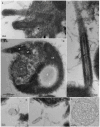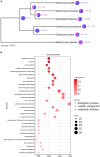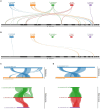Genomic characterisation and ecological distribution of Mantoniella tinhauana: a novel Mamiellophycean green alga from the Western Pacific
- PMID: 38774501
- PMCID: PMC11106453
- DOI: 10.3389/fmicb.2024.1358574
Genomic characterisation and ecological distribution of Mantoniella tinhauana: a novel Mamiellophycean green alga from the Western Pacific
Abstract
Mamiellophyceae are dominant marine algae in much of the ocean, the most prevalent genera belonging to the order Mamiellales: Micromonas, Ostreococcus and Bathycoccus, whose genetics and global distributions have been extensively studied. Conversely, the genus Mantoniella, despite its potential ecological importance, remains relatively under-characterised. In this study, we isolated and characterised a novel species of Mamiellophyceae, Mantoniella tinhauana, from subtropical coastal waters in the South China Sea. Morphologically, it resembles other Mantoniella species; however, a comparative analysis of the 18S and ITS2 marker genes revealed its genetic distinctiveness. Furthermore, we sequenced and assembled the first genome of Mantoniella tinhauana, uncovering significant differences from previously studied Mamiellophyceae species. Notably, the genome lacked any detectable outlier chromosomes and exhibited numerous unique orthogroups. We explored gene groups associated with meiosis, scale and flagella formation, shedding light on species divergence, yet further investigation is warranted. To elucidate the biogeography of Mantoniella tinhauana, we conducted a comprehensive analysis using global metagenomic read mapping to the newly sequenced genome. Our findings indicate this species exhibits a cosmopolitan distribution with a low-level prevalence worldwide. Understanding the intricate dynamics between Mamiellophyceae and the environment is crucial for comprehending their impact on the ocean ecosystem and accurately predicting their response to forthcoming environmental changes.
Keywords: Mamiellophyceae; Mantoniella tinhauana sp. nov.; biogeography; genomics; marine algae; metagenomics.
Copyright © 2024 Rey Redondo, Xu and Yung.
Conflict of interest statement
The authors declare that the research was conducted in the absence of any commercial or financial relationships that could be construed as a potential conflict of interest.
Figures








Similar articles
-
Genomic and biogeographic characterisation of the novel prasinovirus Mantoniella tinhauana virus 1.Environ Microbiol Rep. 2024 Oct;16(5):e70020. doi: 10.1111/1758-2229.70020. Environ Microbiol Rep. 2024. PMID: 39392286 Free PMC article.
-
Mantoniella beaufortii and Mantoniella baffinensis sp. nov. (Mamiellales, Mamiellophyceae), two new green algal species from the high arctic1.J Phycol. 2020 Feb;56(1):37-51. doi: 10.1111/jpy.12932. Epub 2019 Nov 17. J Phycol. 2020. PMID: 31608987
-
Novel diversity within marine Mamiellophyceae (Chlorophyta) unveiled by metabarcoding.Sci Rep. 2019 Mar 26;9(1):5190. doi: 10.1038/s41598-019-41680-6. Sci Rep. 2019. PMID: 30914730 Free PMC article.
-
The Minderoo-Monaco Commission on Plastics and Human Health.Ann Glob Health. 2023 Mar 21;89(1):23. doi: 10.5334/aogh.4056. eCollection 2023. Ann Glob Health. 2023. PMID: 36969097 Free PMC article. Review.
-
Metagenomic studies of the Red Sea.Gene. 2016 Feb 1;576(2 Pt 1):717-23. doi: 10.1016/j.gene.2015.10.034. Epub 2015 Oct 23. Gene. 2016. PMID: 26526132 Review.
Cited by
-
Genomic and biogeographic characterisation of the novel prasinovirus Mantoniella tinhauana virus 1.Environ Microbiol Rep. 2024 Oct;16(5):e70020. doi: 10.1111/1758-2229.70020. Environ Microbiol Rep. 2024. PMID: 39392286 Free PMC article.
References
-
- Aiyar A. (1999). “The use of CLUSTAL W and CLUSTAL X for multiple sequence alignment” in Bioinformatics methods and protocols. eds. Misener S., Krawetz S. A. (Totowa, NJ: Humana Press; ).
-
- Alonso-González A., Orive E., David H., García-Etxebarria K., Garrido J. L., Laza-Martínez A., et al. . (2014). Scaly green flagellates from Spanish Atlantic coastal waters: molecular, ultrastructural and pigment analyses. Bot. Mar. 57, 379–402. doi: 10.1515/bot-2013-0108 - DOI
-
- Baldwin B. G., Sanderson M. J., Porter J. M., Wojciechowski M. F., Campbell C. S., Donoghue M. J. (1995). The ITS region of nuclear ribosomal DNA: a valuable source of evidence on angiosperm phylogeny. Ann. Mo. Bot. Gard. 82, 247–277. doi: 10.2307/2399880 - DOI
-
- Balzano S., Gourvil P., Siano R., Chanoine M., Marie D., Lessard S., et al. . (2012). Diversity of cultured photosynthetic flagellates in the north East Pacific and Arctic oceans in summer. Biogeosci. Discuss. 9, 4553–4571. doi: 10.5194/bgd-9-6219-2012 - DOI
-
- Bandi V., Gutwin C., Siri J. N., Neufeld E., Sharpe A., Parkin I. (2022). Visualization tools for genomic conservation. New York, NY: Springer US. - PubMed
LinkOut - more resources
Full Text Sources

